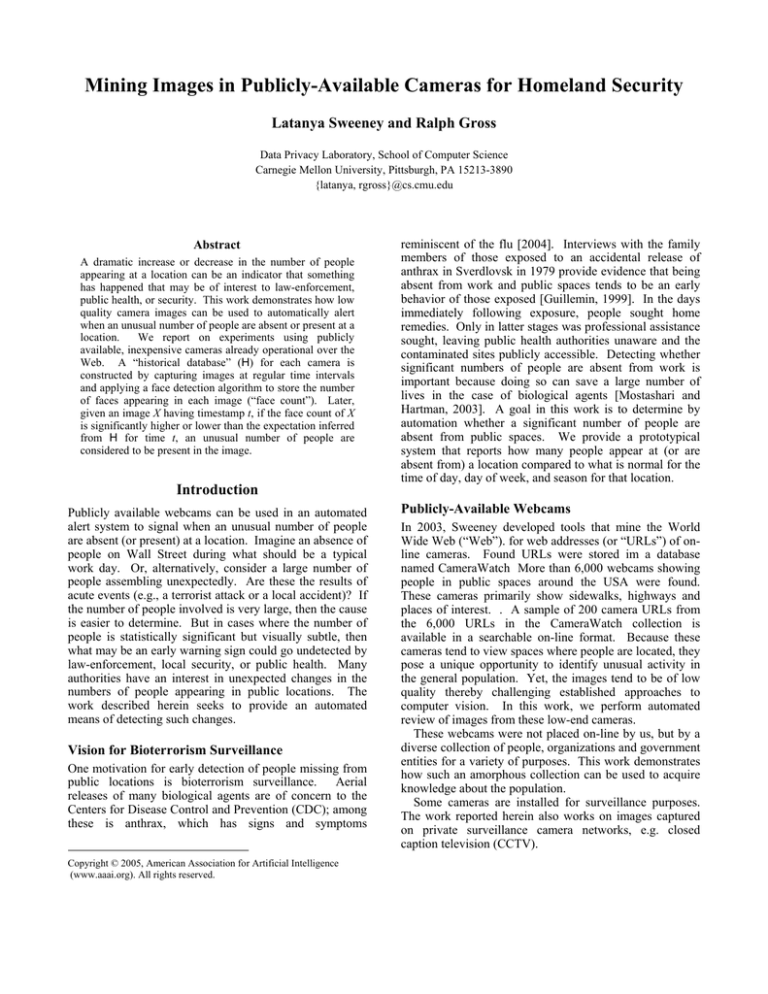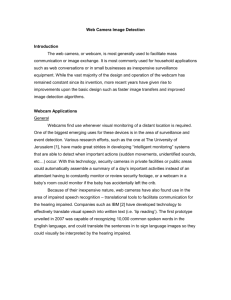
Mining Images in Publicly-Available Cameras for Homeland Security
Latanya Sweeney and Ralph Gross
Data Privacy Laboratory, School of Computer Science
Carnegie Mellon University, Pittsburgh, PA 15213-3890
{latanya, rgross}@cs.cmu.edu
Abstract
1
A dramatic increase or decrease in the number of people
appearing at a location can be an indicator that something
has happened that may be of interest to law-enforcement,
public health, or security. This work demonstrates how low
quality camera images can be used to automatically alert
when an unusual number of people are absent or present at a
location.
We report on experiments using publicly
available, inexpensive cameras already operational over the
Web. A “historical database” (H) for each camera is
constructed by capturing images at regular time intervals
and applying a face detection algorithm to store the number
of faces appearing in each image (“face count”). Later,
given an image X having timestamp t, if the face count of X
is significantly higher or lower than the expectation inferred
from H for time t, an unusual number of people are
considered to be present in the image.
Introduction
Publicly available webcams can be used in an automated
alert system to signal when an unusual number of people
are absent (or present) at a location. Imagine an absence of
people on Wall Street during what should be a typical
work day. Or, alternatively, consider a large number of
people assembling unexpectedly. Are these the results of
acute events (e.g., a terrorist attack or a local accident)? If
the number of people involved is very large, then the cause
is easier to determine. But in cases where the number of
people is statistically significant but visually subtle, then
what may be an early warning sign could go undetected by
law-enforcement, local security, or public health. Many
authorities have an interest in unexpected changes in the
numbers of people appearing in public locations. The
work described herein seeks to provide an automated
means of detecting such changes.
Vision for Bioterrorism Surveillance
One motivation for early detection of people missing from
public locations is bioterrorism surveillance. Aerial
releases of many biological agents are of concern to the
Centers for Disease Control and Prevention (CDC); among
these is anthrax, which has signs and symptoms
Copyright © 2005, American Association for Artificial Intelligence
(www.aaai.org). All rights reserved.
reminiscent of the flu [2004]. Interviews with the family
members of those exposed to an accidental release of
anthrax in Sverdlovsk in 1979 provide evidence that being
absent from work and public spaces tends to be an early
behavior of those exposed [Guillemin, 1999]. In the days
immediately following exposure, people sought home
remedies. Only in latter stages was professional assistance
sought, leaving public health authorities unaware and the
contaminated sites publicly accessible. Detecting whether
significant numbers of people are absent from work is
important because doing so can save a large number of
lives in the case of biological agents [Mostashari and
Hartman, 2003]. A goal in this work is to determine by
automation whether a significant number of people are
absent from public spaces. We provide a prototypical
system that reports how many people appear at (or are
absent from) a location compared to what is normal for the
time of day, day of week, and season for that location.
Publicly-Available Webcams
In 2003, Sweeney developed tools that mine the World
Wide Web (“Web”). for web addresses (or “URLs”) of online cameras. Found URLs were stored im a database
named CameraWatch More than 6,000 webcams showing
people in public spaces around the USA were found.
These cameras primarily show sidewalks, highways and
places of interest. . A sample of 200 camera URLs from
the 6,000 URLs in the CameraWatch collection is
available in a searchable on-line format. Because these
cameras tend to view spaces where people are located, they
pose a unique opportunity to identify unusual activity in
the general population. Yet, the images tend to be of low
quality thereby challenging established approaches to
computer vision. In this work, we perform automated
review of images from these low-end cameras.
These webcams were not placed on-line by us, but by a
diverse collection of people, organizations and government
entities for a variety of purposes. This work demonstrates
how such an amorphous collection can be used to acquire
knowledge about the population.
Some cameras are installed for surveillance purposes.
The work reported herein also works on images captured
on private surveillance camera networks, e.g. closed
caption television (CCTV).
1.
2.
3.
A “historical database” (H) for a camera is constructed by
capturing images at regular time intervals throughout each
day and applying a face detection algorithm to each image
captured. The number of faces appearing in each image
(“face count”) along with a date and timestamp are stored.
Averages and standard deviations are computed for each
time interval in H over varying classes to which the date and
time stamp belongs.
Date classes include current
weekdays/weekend, day of week, time of month, and
seasons. Holidays and events are a special class.
Given an image X having timestamp tX, if the face count of X
is more than 2 standard deviations above the average (or 2
standard deviations below the average) of any class to
which tx belongs, then an unusual number of people are
considered to be present in the image.
Figure 1. Overall approach for detecting whether an unusual
number of people are appearing in a camera image.
Figure 2. View from a publicly available webcam used to
answer the question: is there an unusual number of people
absent from (or present in) public spaces? Ten faces were
automatically detected in this image.
Methods and Results
Materials
In conducting experiments, we used: (1) the CameraWatch
database; (2) a specific webcam; and, (3) a face detection
program. Each of these are described below.
CameraWatch Database and The Webcam. The
CameraWatch database contains more than 6,000 URLs of
publicly available webcams [Sweeney, 2003]. One URL,
www.earthcam.com/cams/newyork/timessquare/index.html,
was selected from CameraWatch as the subject of these
experiments and is termed “the Webcam.” The Webcam
views Time Square (1552 Broadway at 46th Street, New
York, NY 10036). Figure 2 provides an example of an
image from the Webcam.
Face
Detection
Program.
Given
an
image,
Schneiderman's face detection program (“Face Detection
Program”) reports the number of faces found by
exhaustively comparing varying size model faces against
all pixel positions [2004]. The Webcam was selected in
part because there is sufficient light, day and night, for the
Face Detection Program to operate.
Historical Database. Images from the Webcam were
captured every 10 minutes, 24 hours a day, for 4 work days
in the winter (December 6, 7, 8 and 10, 2004). It rained
for 2 of the 4 days. The Face Detection Program was
applied to each image and the results stored, along with the
date and timestamp of the image capture.
Experiment 1: Average Face Counts
Figure 3 shows the average number of faces detected for
each time interval in the Historical Database. Someone is
almost always present and the most number of people are
present at lunch and dinnertime. 3am has fewest people.
Averages for rain and non-rain days are smoother, less
noisy curves of the same shape as in Figure 3.
Experiment 2: Detected Faces and Actual People
A manual count of the actual number of people appearing
in each image was done. People whose heads (not
necessarily faces) appear in the store or on the sidewalk up
to the mailboxes are included. See Figure 2, which has a
manual count of 11 people. A linear regression between
the number of faces detected in the Historical Database
and the actual number of people counted in the earlier part
of the day (no rain) has R2=0.76 (best is 1). Performance
deteriorates with rain (perhaps due to occlusion by
umbrellas and crowding under umbrellas) and other
confounders. No performance difference was found
between daylight and street lights.
12
Average Number of Faces
(Detected)
Hutwagner et al. at CDC proposed an aberration detection
model for bioterrorism surveillance of hospital data [2002].
Deviations in current data are compared to a historical
average. Our approach builds on this notion. In the initial
phase a historical database of images is constructed from
which averages are computed (steps 1 and 2 in Figure 1).
Then, in an operational phase, a decision is made about the
number of people appearing in a given image based on
shifts away from the mean (step 3 in Figure 1).
10
8
6
4
2
0
0:00
6:00
12:00
18:00
0:00
Time of Day
Figure 3. Average number of faces detected in webcam
images (see Figure 2) during a standard weekday from one
week in the winter. Noon (12:00) is the most popular time
and 3am (3:00) is least popular.
Discussion
20
While this work provides a proof of concept that webcams
can report whether there is an unusual number of people at
a location, much more work is needed to validate,
generalize and improve these findings. For example,
counting faces as a proxy for people is problematical. One
can imagine a camera view in which the backs of people
(not their faces) are usually visible. Constructing a
“person detector” rather than using a face detector seems
prudent.
In concluding, we address privacy. With almost 6,000
publicly-available web cams already showing public
spaces around the USA, this approach offers a low-cost
national surveillance system. But it offers it to anyone in
the world. Not only is that a concern of personal privacy,
but perhaps also of national security. On the other hand,
there may be many worthy uses for this network of
webcams. For this reason, we introduce the notion of
“smart cameras” in which high-level information from
webcams, and not actual images, is shared. We envision
that smart cameras will include programs within, such as
this work, and would provide reports, updates and alerts,
and not images.
15
10
5
22:30
21:00
19:30
18:00
16:30
15:00
13:30
12:00
9:00
10:30
7:30
6:00
4:30
3:00
1:30
0
0:00
Number of Faces (Detected)
25
Time of Day
Figure 4 Range of values considered “normal” for the
time of day (middle area). Values above (top) or below
the middle area (bottom area) are considered “unusual.”
Experiment 3: Alarm Thresholds
The range of values considered “normal” for the Historical
Database for each time interval is computed by taking the
averages (Figure 3) and adding and subtracting 2 standard
deviations from each. Figure 4 shows the resulting range
of values. If the number of people typical at noon
appeared in a camera image captured at 3am (or vice
versa), the population would be considered “unusual” for
that time period being above (or below) the range of
normal values.
Related Work in Computer Vision
One might wonder whether face recognition would
improve results. Several large scale evaluations of face
recognition systems have shown that the performance of
face recognition systems is most affected by face pose and
illumination, and to a much lesser degree by image
resolution and image quality [Gross et al., 2001; Phillips et
al., 2003; Blackburn et. al, 2000]. Blackburn et al. reduced
the distance between the eyes from 60 pixels to 15 pixels
with only minimal performance degradation —from 94%
to 92% rank 1 (top choice) accuracy for the best
performing system. They reduced image quality through
increasing JPEG compression up to 40:1. Rank 1 accuracy
decreased moderately (from 63% to 56%). Other imaging
conditions such as face pose and illumination were kept
constant. Images captured in unconstrained conditions
with low-quality cameras are currently still beyond the
capabilities of face recognition systems.
A number of research groups have addressed the
problem of monitoring traffic, either on a highway or
around city intersections. However, these systems require
high quality image input and/or significant user interaction
at system startup time. Beymer et al. [1997] proposed a
system to track vehicles under congestion, but for the
tracking algorithm to work the user has to manually
specify a set of camera-specific parameters. Eikvil et al.
[2001] proposed to use Hidden Markov Models to perform
traffic surveillance. Again the system requires a supervised
initialization phase.
Acknowledgements
Much gratitude goes to Sylvia Barrett and Katya
Mirochnik for aid in reviewing and capturing images, and
to Henry Schneiderman for the use of his face detection
program.
References
Beymer, D., McLauchlan, P., Coifman,, B. and Malik, J. A RealTime Computer Vision System for Measuring Traffic. IEEE
Conference on Computer Vision and Pattern Recognition, 1997.
Blackburn, D. M. and Bone, M. and Phillips, P. J. Facial
Recognition Vendor Test 2000: evaluation report, 2000.
CDC, 2004, <www.bt.cdc.gov/agent/agentlist.asp>.
Eikvil, L. and Huseby, R. Traffic Surveillance in Real-time using
HMMs. Scandinavian Conference on Image Analysis, 2001.
Gross, R. and Shi, J. and Cohn, J. Quo Vadis Face Recognition?
3rd Workshop on Empirical Eval Methods Computer Vision 2001.
Hutwagner, L., Seeman, M., Thomson, W., Treadwell, T. CDC:
Early Aberration Reporting. Syndromic Surveillance Conf. 2002.
Guillemin, J. Anthrax: The Investigation of a Deadly Outbreak.
Dec. 1999. Univ. of California Press.
Mostashari, F. and Hartman, J. Syndromic surveillance: a local
perspective. Journal of Urban Health, 80 (2) 2003.
Phillips, P.J. and Grother, P. and Ross, J. M. and Blackburn, D.
and Tabassi, E. and Bone, M. Face Recognition Vendor Test
2002: evaluation report, 2003.
Schneiderman, H. Learning an Restricted Bayesian Network for
Object Detection. IEEE CVPR, 2004.
Sweeney, L.
CameraWatch.
Data Privacy Lab, 2003.
<privacy.cs.cmu.edu/dataprivacy/projects/camwatch/>





